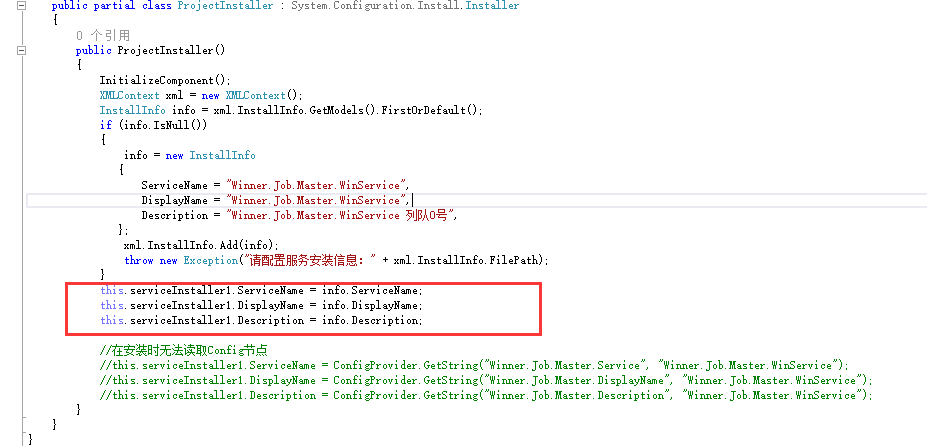《WinService服务》
说道Windows服务基本每个以.net为主要开发语言的技术团队都会用到这个,Winner2.0中对于WinServices也有一些与众不同的地方。
正常来说,每次开发一个项目如果我们要用到Windows服务就要单独在项目下建立一个WinService。其实WinService 就是一个壳子。
但是每次为了这个壳子都要投产到服务器还要通过cmd命令去部署。
因为一直习惯这么做,可能不会觉得麻烦,但是项目一多就会发现要部署几十个服务那不那么顺心了。所以Jason开发了一套“WinServiceJob”工具。
先说说有点再说是怎么实现的:
1,无需新建WinService服务项目。
2,无需cmd命令部署。
3,更新无需停止服务。
从思路上来说,Jason开发的WinServiceJob思路和《短信中心》是一样的(本身两个项目也都是Jason开发的)。
简单讲就是 WinServiceJob 是一个类似Docker的容器,它本身不做任何业务。具体业务是读取数据库的配置然后反射程序集来执行的。

WinServiceJob ,就是个空壳子。所有项目只需要编译一个service程序集然扔到 WinServiceJob 项目下,然后数据库一配置WinServiceJob 就会
帮我们去执行工作,这里可以通过Cycle字段来配置执行周期,是一天一次还是60分钟一次。每次执行完一个服务之后更新NextRunTime保存下一次
执行时间。
这样省去了程序员们每次开发Windows 服务时的琐碎事情,只需在当前开发项目编译一个要执行的service.dll 然后交给WinServiceJob 管理人员
就行了。看了前面《短信中心》讲解的就应该很清楚,要支持这种写法必须要求所有的执行项目要继承接口约束。
using System.Collections.Generic; using System.Linq; using System.Text; using System.Threading.Tasks; namespace Winner.Job.Master.Interface { /// <summary> /// WinService工作单元接口 /// </summary> public interface IJob { /// <summary> /// 执行工作单元 /// </summary> /// <param name="runTime"></param> /// <returns>返回执行结果JobResult</returns> JobResult Run(DateTime runTime); } }
两个值得一说的地方:
1,WinServiceJob更新时服务无需重启;
2,WinServiceJob可以在服务器上部署多个;
这两个地方实现的方式也很特殊,先来看一段代码:
using System; using System.Collections.Generic; using System.Linq; using System.Reflection; using System.Runtime.Remoting.Lifetime; using System.Text; using System.Threading.Tasks; using Winner.Job.Master.Interface; namespace Winner.Job.Master.Remoting { /// <summary> /// 远程处理的应用程序中跨应用程序域边界访问对象。 /// </summary> public class RemoteLoader : MarshalByRefObject { private Assembly _assembly; public void LoadAssembly(string assemblyFile) { try { _assembly = Assembly.LoadFrom(assemblyFile); } catch (Exception ex) { throw ex; } } public T GetInstance<T>(string typeName) where T : class { if (_assembly == null) return null; var type = _assembly.GetType(typeName); if (type == null) return null; return Activator.CreateInstance(type) as T; } public JobResult ExecuteMothod(string typeName, DateTime? runtime) { if (_assembly == null) { return JobResult.FailResult("加载程序集失败"); } var type = _assembly.GetType(typeName); var obj = Activator.CreateInstance(type); IJob job = obj as IJob; return job.Run(runtime.HasValue ? runtime.Value : DateTime.Now); } public override object InitializeLifetimeService() { ILease aLease = (ILease)base.InitializeLifetimeService(); if (aLease.CurrentState == LeaseState.Initial) { // 不过期:TimeSpan.Zero aLease.InitialLeaseTime = TimeSpan.FromMinutes(1000); } return aLease; } } }
这是一个远程调用的工具类,每个子服务中必须把这个程序集放到目录下,主服务拿子服务的目录下RemoteLoader来获取子服务的信息,
准确来说是服务名:
using System; using System.Collections.Generic; using System.IO; using System.Linq; using System.Reflection; using System.Text; using System.Threading.Tasks; using Winner.Framework.Utils; using Winner.Job.Master.DataAccess; using Winner.Job.Master.Entites; using Winner.Job.Master.Entites.Map; using Winner.Job.Master.Interface; using Winner.Job.Master.Remoting; namespace Winner.Job.Master.Facade { /// <summary> /// 工作计划服务对象 /// </summary> [Serializable] public class JobService { public void Execute(JobMap job) { try { //远程执行服务 var result = RemoteExecute(job); if (!result.Success) { job.Status = (int)JobStatus.失败; job.ErrorInfo = result.Message; } else { job.Status = (int)JobStatus.成功; job.ErrorInfo = string.Empty; } //计算状态和下次运行情况 ModifyModel(job); //修改数据库时间 Modify(job); //GC回收 GC.Collect(); } catch (Exception ex) { Log.Error(ex); } } /// <summary> /// 远程执行 /// </summary> /// <param name="job"></param> /// <returns></returns> private JobResult RemoteExecute(JobMap job) { AppDomain appDomain = null; try { //服务反射信息 string[] array = job.TypeConfig.Split(','); //服务的程序集名称 string assemblyFile = array[0]; //服务的类名称 string className = array[1]; //设置AppDomain安装程序信息 AppDomainSetup setup = new AppDomainSetup(); //服务名称 setup.ApplicationName = job.ServiceName; //安装(运行)目录(提示:在当前运行目录的子目录,而子目录则是”服务名称“) setup.ApplicationBase = Path.Combine(AppDomain.CurrentDomain.BaseDirectory, job.ServiceName); setup.ShadowCopyDirectories = setup.ApplicationBase; setup.ShadowCopyFiles = "true"; //Config配置文件路径 setup.ConfigurationFile = Path.Combine(setup.ApplicationBase, assemblyFile + ".dll.config"); //构造一个新的AppDomain appDomain = AppDomain.CreateDomain(job.ServiceName, null, setup); //获取远程调用程序 对象名称 string name = Assembly.LoadFile(Path.Combine(setup.ApplicationBase, "Winner.Job.Master.Remoting.dll")).GetName().FullName; //创建远程调用程序实例 var remoteLoader = (RemoteLoader)appDomain.CreateInstanceAndUnwrap(name, typeof(RemoteLoader).FullName); //加载服务程序集 remoteLoader.LoadAssembly(Path.Combine(setup.ApplicationBase, assemblyFile + ".dll")); //执行服务 var result = remoteLoader.ExecuteMothod(className, job.NextRunTime); Log.Info(string.Format("执行结果:Service={0} Success={1} Message={2}", job.ServiceName, result.Success, result.Message)); return result; } catch (Exception ex) { Log.Error("执行服务异常", ex); return JobResult.FailResult("远程执行服务出现异常:" + ex.Message); ; } finally { if (appDomain != null) { Log.Info("卸载AppDomain:" + appDomain.FriendlyName); AppDomain.Unload(appDomain); appDomain = null; } } } private void ModifyModel(JobMap job) { if (job == null) return; if (job.Status != (int)JobStatus.暂停 && job.Status != (int)JobStatus.成功 && job.IsContinue == 2) { job.RetryTime = DateTime.Now.AddMinutes(job.RetryInterval); return; } if (job.IsContinue == 1 || job.Status == (int)JobStatus.成功) { job.NextRunTime = job.NextRunTime.HasValue ? job.NextRunTime.Value : DateTime.Now; if (job.Cycle != 0) { if (job.Cycle < 0) job.NextRunTime = job.NextRunTime.HasValue ? job.NextRunTime.Value.AddMinutes(0 - job.Cycle) : DateTime.Now.AddMinutes(0 - job.Cycle); else { switch ((Cycle)job.Cycle) { case Cycle.Daily: job.NextRunTime = job.NextRunTime.Value.AddDays(1); break; case Cycle.Fortnightly: job.NextRunTime = job.NextRunTime.Value.AddDays(14); break; case Cycle.Monthly: job.NextRunTime = job.NextRunTime.Value.AddMonths(1); break; case Cycle.Weekly: job.NextRunTime = job.NextRunTime.Value.AddDays(7); break; case Cycle.Yearly: job.NextRunTime = job.NextRunTime.Value.AddYears(1); break; default: break; } } } } } private bool Modify(JobMap job) { Tsys_Winservice daWinService = new Tsys_Winservice(); daWinService.WinServiceId = job.WinServiceId; daWinService.NextRunTime = job.NextRunTime; daWinService.Status = job.Status; daWinService.RetryTime = job.RetryTime; daWinService.RetryInterval = job.RetryInterval; if (!daWinService.Update()) { return false; } return true; } } }
这里采用的方式是,每次新的服务去创建一个新的APPDomain 和 线程去执行,执行完了之后线程同步,APPDomain 也卸载掉。
包括使用影加载,这里的效果就是不会对dll进行文件占用,所以随意更新dll是不不需要去重启服务的。
另外前面有说到 新增一个子服务 也可以不需要重启服务,这种方式是可以实现的,但是因为要不停的读取数据库,所以后期修改了一下。
为了避免每次时时刻刻都要去扫数据库,所以采用了一次性加载到队列当中,然后如果有更新服务的话,还是要重启WinServiceJob。
最后,要说的是如果一个WinServiceJob可能负载的子服务太多造成臃肿执行性能低的话,我们可以部署多个。由于Winservice重名的话是
部署不了的。所以这里WinServiceJob在部署时具体的名称我们是从xml配置文件中读取的。
<?xml version="1.0" encoding="utf-8"?> <Root> <InstallInfo> <ServiceName value="Winner.Job.Master.WinService" /> <DisplayName value="Winner.Job.Master.DisplayName" /> <Description value="Winner.Job.Master.Description 列队0号" /> </InstallInfo> </Root>
C# 这边就读取配置文件就行了:

这里当时特地还做了测试,直接从APP.Config文件中读取是读不到的,所以要单独写xml文件去配置。
我们来看看最终的部署结构目录:

我们在实际的使用过程中差不多一个WinServiceJob负载了二三十个服务在跑。 总共开发的四五年里我们写的WinService不下上百个。
WinServiceJob 帮程序员省去了开发服务,部署服务的一系列琐碎事宜。
好了,就写到这里。最后一句话:代码不重要,还是思想。WinServiceJob主要还是模仿了类似Docker容器这种思想来做的。
这里我把整个WinServiceJob 的代码全部开源到GitHub方便大家参考:https://github.com/demon28/WinServiceJob
有兴趣一起探讨Winner框架的可以加我们QQ群:261083244。或者扫描左侧二维码加群。